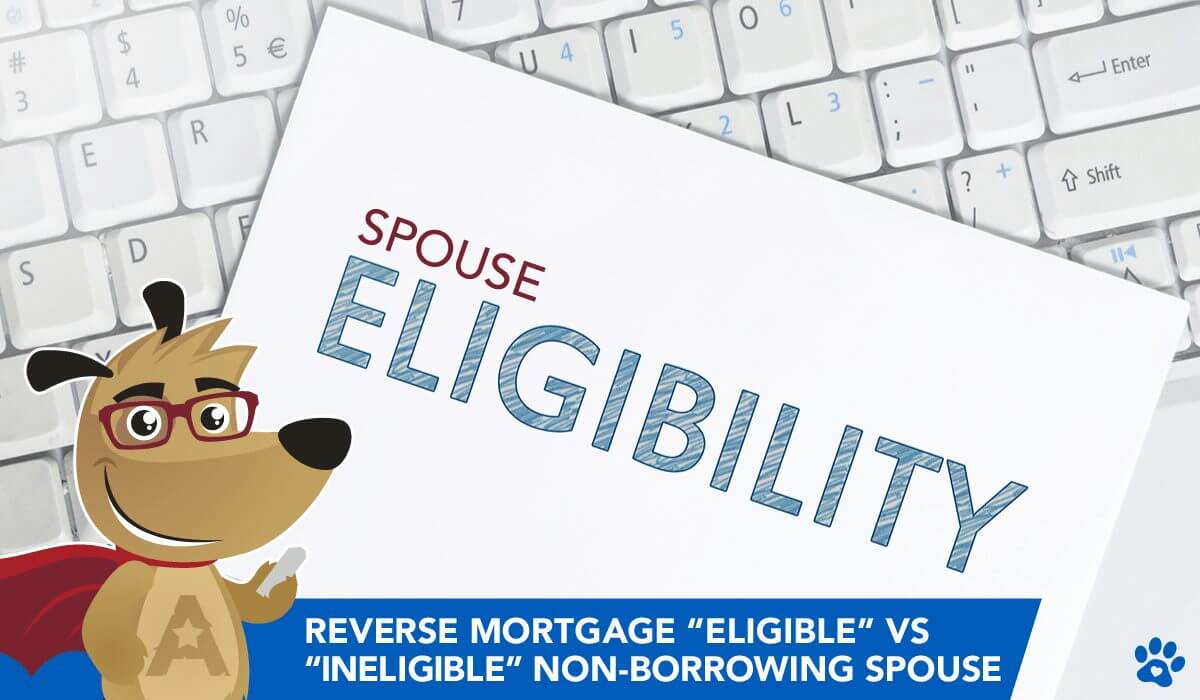Reverse Mortgage Spouse: “Eligible” vs. “Ineligible” Protection
 |
Michael G. Branson, CEO of All Reverse Mortgage, Inc., and moderator of ARLO™, has 45 years of experience in the mortgage banking industry. He has devoted the past 20 years to reverse mortgages exclusively. (License: NMLS# 14040) |
 |
All Reverse Mortgage's editing process includes rigorous fact-checking led by industry experts to ensure all content is accurate and current. This article has been reviewed, edited, and fact-checked by Cliff Auerswald, President and co-creator of ARLO™. (License: NMLS# 14041) |
Who is an eligible non-borrowing spouse on a reverse mortgage?
Great Question!
There are two types of non-borrowing spouses in a reverse mortgage: eligible and ineligible non-borrowing spouses. To be considered an eligible non-borrowing spouse, you must be married to the borrower when they apply for and close the loan.
As an eligible non-borrowing spouse, you must also meet certain requirements, such as living in the home as your primary residence. If the borrower passes away, you can continue living in the home, but you must keep up with property taxes, insurance, and basic maintenance of the house.
If you’re not already on the title, you will need to obtain it after the borrower passes away. Although you won’t be a borrower on the loan, meaning you can’t access any remaining funds from the reverse mortgage, the loan won’t become due as long as you continue to meet these conditions. This deferral allows you to stay in your home without the immediate burden of repaying the loan.

What other changes would have been necessary if HUD had fixed the non-borrowing spouse issue in 2014?
HUD’s rule changes, announced in 2014 and effective in early 2015, did not go far enough to protect spouses. For one, it did not cover any spouses of loans closed before that time. In other words, if you completed a loan before the change, your loan was still due and payable if your borrowing spouse passed.
The changes that took effect in 2015 only covered those loans that closed from that time forward. All spouses of borrowers who received the loan before 2015 were still not covered, and if their spouse passed, even after the HUD changes, their loan was called due and payable at that time.
This was because, with the new changes, all new loans were based on the younger spouse’s age, even though they were not borrowers on loans. Because they had an eligible status for deferral, their age was considered when the loan eligibility was determined.
Loans closed before the underaged spouse was removed from the title did not consider the younger spouse’s age in the age calculation. Therefore, a 77-year-old borrower with a 55-year-old spouse would receive a lot more money before the 2014 changes, but that spouse was also not eligible for deferral of the call provisions when their spouse passed.
Secondly, the rule, written in 2014 and made effective in 2015, did not protect spouses of borrowers forced to leave home due to medical reasons. If the borrowing spouse were forced to go home for more than 12 consecutive months due to the need for hospice care, the loan would be called due and payable by the lender under the HUD rules because the move was considered permanent.
This created many problems for spouses who met all other conditions, but their spouse did not pass but needed to be placed into assisted living for medical reasons. Then, their loan became due and payable under the HUD rules.
HUD’s new treatment of non-borrowing spouses
HUD fixed these issues with its new treatment of non-borrowing spouses as outlined in HUD Mortgagee Letter (ML) 2021-11, further extending protections granted by HUD’s previous guidance on the subject in HUD Mortgagee Letter (ML) 2019-15. Effective immediately, all non-borrowing spouses, not just those whose loans began after the 2014 change date, now have the non-borrowing spouse deferral protection.
This is a considerable comfort and protection for spouses who were not on the loan their spouse received and feared losing their ability to remain in their homes. Furthermore, HUD removed the provision that the loan could still be called due and payable if the borrowing spouse had to leave home for more than 12 months due to medical reasons for all non-borrowing spouses who held this designation at the time the loan was closed.
In other words, the non-borrowing spouse is protected from having to leave their home due to the call provision due to their spouse’s death and the medical need to go home now. This is especially important because HUD determined that they would cover spouses before their age, which was also considered in loan amount calculations, so they got an advantage in the additional funds available.
What spouses are not covered?
For a person to be considered a spouse, the borrower must consider them a spouse and declare them a spouse when the loan is closed. Remember that this still does not cover spouses not married to the borrower when the loan closed. New individuals who became spouses after the loan’s closing are still not covered under the existing reverse mortgage.
In other words, borrowers cannot try to add someone claiming to be a common-law spouse when the loan closed, but they stated they were unmarried. For newly married spouses, the only way to still ensure that the terms of a reverse mortgage cover them, if that is your goal, is to obtain a new loan in both your names or with them being a current “eligible non-borrowing spouse” now at the time you take out the new loan if they are not yet 62 years of age.
Do you know if there are any other changes or things you need to know?
Non-borrowing spouses cannot access the loan after the borrower passes. This means that if funds are still available on the line of credit, they remain unborrowed and do not need to be repaid when the loan is closed, but the non-borrowing spouse cannot make additional draws against the line. The non-borrowing spouse may remain in the home for as long as they desire if they meet the eligibility criteria.
If the non-borrowing spouse does not have title to the property within 90 days of the borrower’s passing, the spouse is no longer required to secure it. This is another improvement, as probate and other issues often stretch transferring title to the remaining spouse beyond the old 90-day requirements by HUD.
Our Recommendations
We recommend that borrowers add the non-borrowing spouse back to the title as soon as the loan closes so that there are no problems later (for those spouses removed from the title before 2015, they are no longer required to be removed as of the 2014 changes). This was more of an issue for the loans closed before 2015 when non-borrowing spouses needed to come off the title, but there is no reason to keep them off the title after the loan closes.
HUD allows borrowers to add anyone they want to title if they are still on title and still living in the home. We also recommend that borrowers write letters authorizing lenders to deal with non-borrowing spouses in all matters relating to the loan so that the non-borrowing spouse has full authorization to deal with the lender on the borrower’s behalf.
If you have a non-borrowing spouse, you should file all paperwork with the lender to allow your spouse full access to the lender and the loan information. In contrast, both spouses are still alive when everyone can sign any required authorization.
To be eligible for deferral of a reverse mortgage, you must be married, live in the home when the loan closes, and still live in the home as your primary residence when the borrowing spouse passes or permanently moves to a medical facility.
Finally, the non-borrowing spouse has the same responsibilities as the borrower regarding the payment of taxes and insurance on time and reasonable maintenance of the home.
An eligible non-borrowing spouse who does this can stay in the home for as long as they live and want to remain.

Ineligible = No Deferral Granted
Ineligible non-borrowing spouses might be those who don’t occupy the property (separated borrowers who do not live in the home), were not married to the borrower at the time the loan was closed, or, because of familial or other issues, cannot get title to the home (perhaps the home goes to other heirs upon the borrower’s death).
They would not be eligible for the deferral; therefore, the loan would be due and payable upon the borrower’s passing. I hope this helps.
Eligible vs. Ineligible Spouse Protections
| Status | Criteria | Implications |
|---|---|---|
| Eligible Non-Borrowing Spouse | Married to the borrower at the time of loan closing and remains married until the borrower's death. | Can remain in the home after the borrower's death without the loan becoming due, under certain conditions. |
| Ineligible Non-Borrowing Spouse | Not married to the borrower at the time of loan closing, or the marriage ends before the borrower's death. | May have to vacate the property or pay off the loan upon the borrower's death. |
Spouse FAQs
Do both spouses need to be 62 for a reverse mortgage?
Can my new spouse be added to my Reverse Mortgage?
What happens if a spouse dies with a reverse mortgage?
What is an eligible non-borrowing spouse?
What is an ineligible non-borrowing spouse?
If you have a reverse mortgage and get remarried, how long does your spouse have to stay home when you pass away?
If one of the spouses dies, can the other stay in the home?
2025 HUD Non-Borrowing Spouse Update:
Proof of marriage is required for an eligible Non-Borrowing Spouse (NBS), with acceptable documentation, including tax returns, a prior deed, or a marriage certificate.

ARLO recommends these helpful resources:




 Michael G. Branson
Michael G. Branson Cliff Auerswald
Cliff Auerswald

April 20th, 2025
April 20th, 2025
January 10th, 2025
January 10th, 2025
October 9th, 2024
October 17th, 2024
August 18th, 2024
August 18th, 2024
April 20th, 2024
April 20th, 2024
December 8th, 2023
December 8th, 2023
September 20th, 2023
September 20th, 2023
November 4th, 2023
November 7th, 2023
September 14th, 2023
September 14th, 2023
September 3rd, 2023
September 3rd, 2023
July 8th, 2023
July 8th, 2023
June 17th, 2023
June 17th, 2023
May 16th, 2023
May 16th, 2023
May 6th, 2023
May 6th, 2023
April 5th, 2023
April 5th, 2023
March 28th, 2023
March 28th, 2023
February 15th, 2023
February 15th, 2023
January 22nd, 2023
January 22nd, 2023
December 5th, 2022
December 5th, 2022
September 27th, 2022
September 27th, 2022
September 14th, 2022
September 14th, 2022
August 17th, 2022
August 17th, 2022
August 2nd, 2022
August 2nd, 2022
August 2nd, 2022
August 2nd, 2022
June 28th, 2022
June 28th, 2022
June 16th, 2022
June 16th, 2022
April 27th, 2022
February 9th, 2022
February 9th, 2022
December 7th, 2021
December 16th, 2021
November 6th, 2021
November 7th, 2021
November 7th, 2021
July 19th, 2021
July 19th, 2021
June 29th, 2021
June 29th, 2021
June 18th, 2021
June 18th, 2021
March 3rd, 2021
March 4th, 2021
February 15th, 2021
February 15th, 2021
February 8th, 2021
February 9th, 2021
January 13th, 2021
January 13th, 2021
December 8th, 2020
December 9th, 2020
December 8th, 2020
December 8th, 2020
September 20th, 2020
September 20th, 2020
October 9th, 2020
October 9th, 2020
September 14th, 2020
September 14th, 2020
September 1st, 2020
September 1st, 2020
August 16th, 2020
August 16th, 2020
July 7th, 2020
July 7th, 2020
May 17th, 2020
May 17th, 2020
May 15th, 2020
May 15th, 2020
May 15th, 2020
May 15th, 2020
April 13th, 2020
April 13th, 2020
March 30th, 2020
March 30th, 2020
March 16th, 2020
March 16th, 2020
January 16th, 2020
January 16th, 2020
November 11th, 2019
November 11th, 2019
October 27th, 2019
October 27th, 2019
October 15th, 2019
October 15th, 2019
September 23rd, 2019
September 23rd, 2019
July 10th, 2019
July 10th, 2019
June 24th, 2019
June 25th, 2019
June 4th, 2019
June 4th, 2019
June 3rd, 2019
June 3rd, 2019
May 24th, 2019
May 24th, 2019
May 13th, 2019
May 13th, 2019
May 11th, 2019
May 14th, 2019
May 10th, 2019
May 10th, 2019
April 11th, 2019
April 11th, 2019